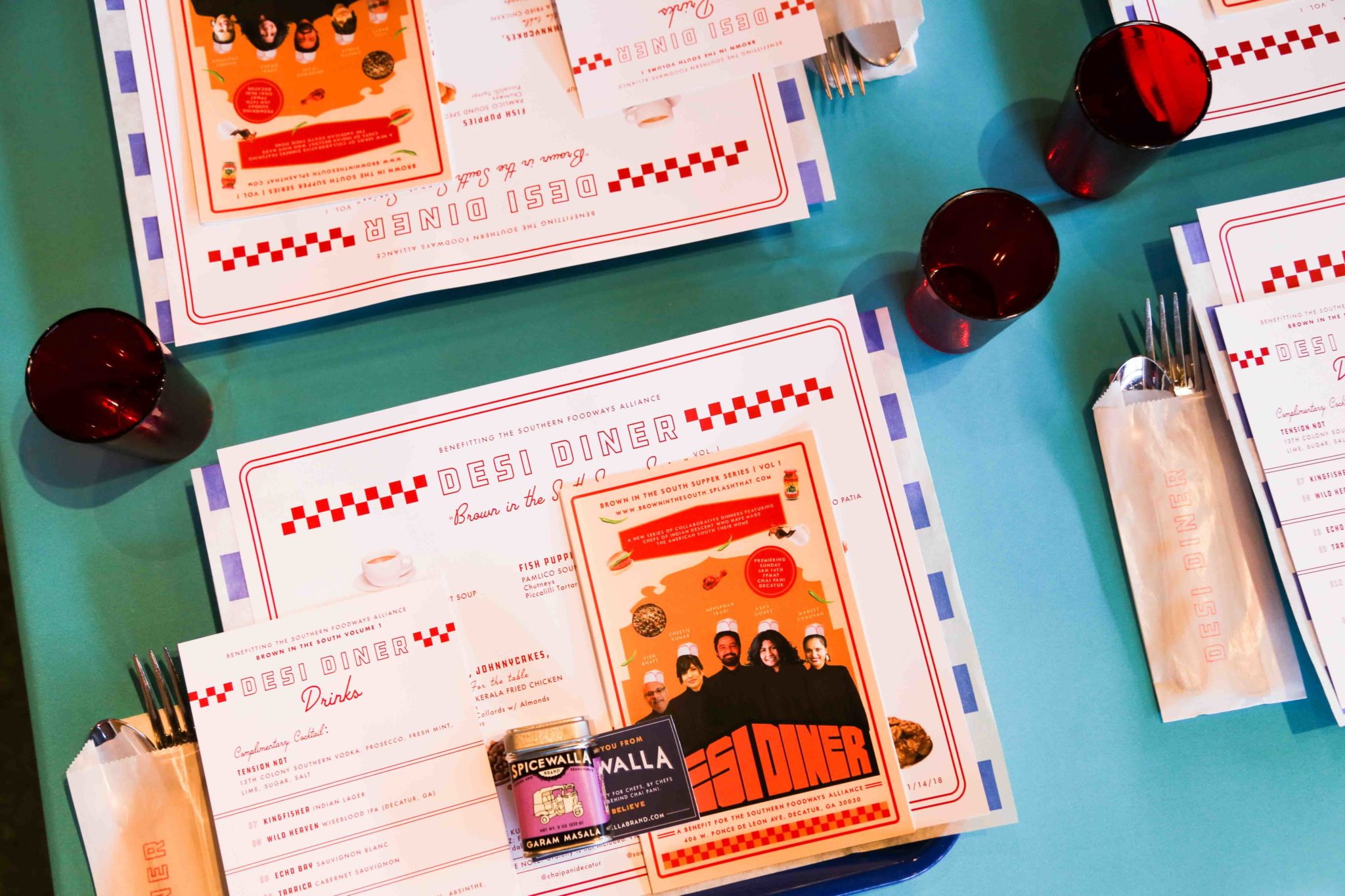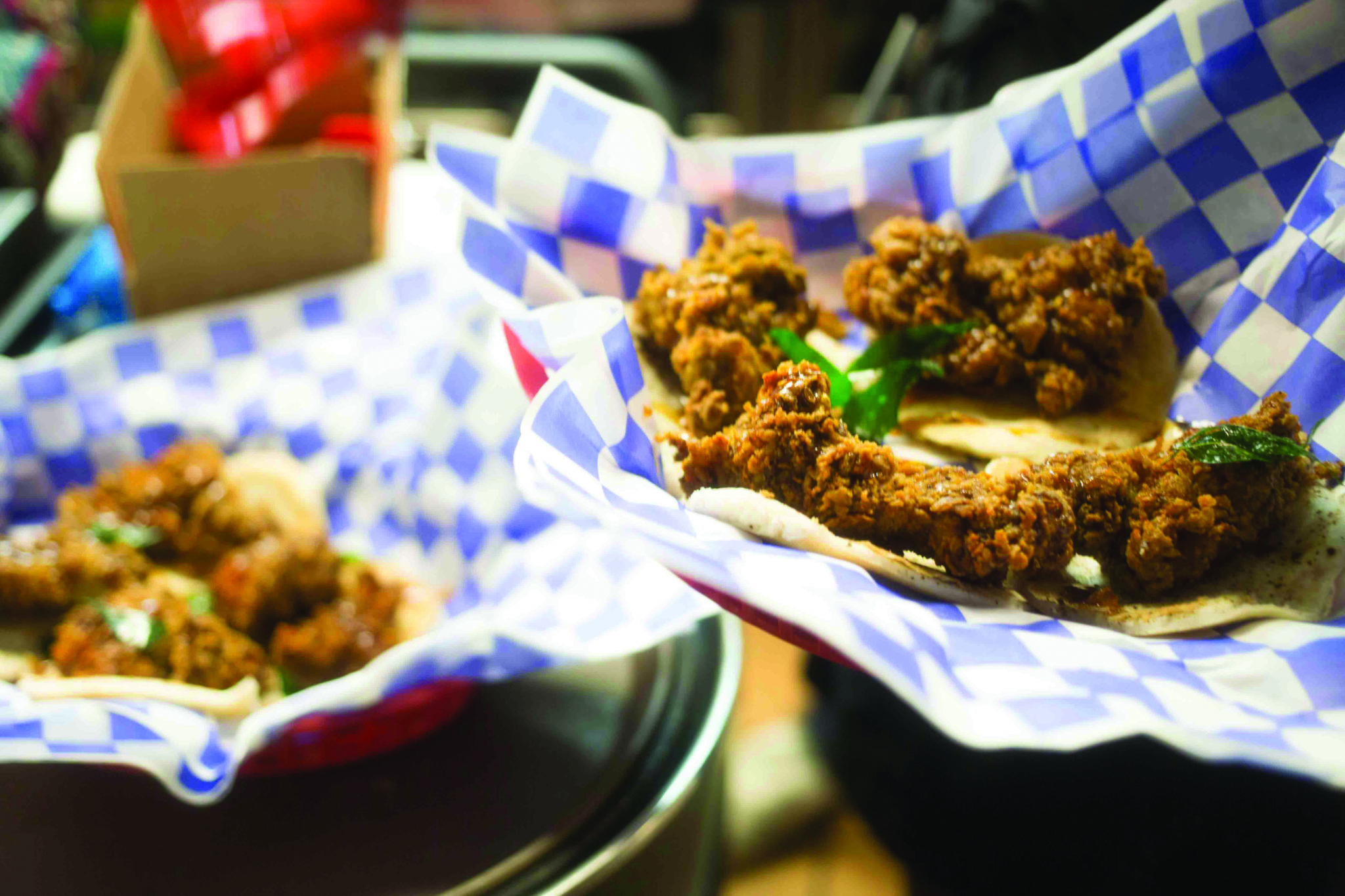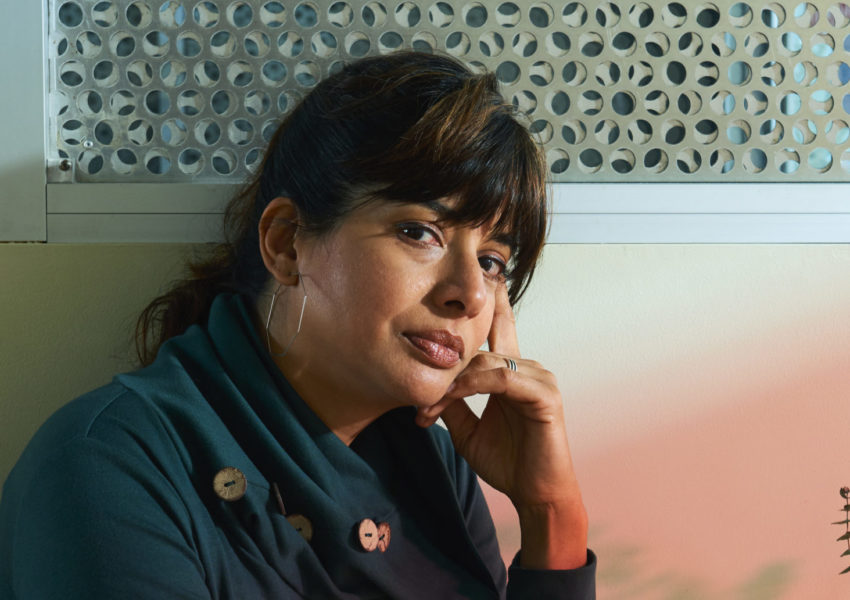A New Normal South Southern cooking by Indian American chefs offers refreshing ways to connect
by Osayi Endolyn
I look around the room at the inaugural Brown in the South dinner, and I shake my head in wonder. This event is the first in a new series, hosted at Meherwan Irani’s Chai Pani restaurant in Decatur, Georgia. It centers chefs of Indian background who live and work in the American South: Irani, Vishwesh Bhatt of City Grocery Restaurant Group in Oxford, Nashville’s Maneet Chauhan of Chauhan Ale and Masala House, cookbook author and founder of Atlanta’s Third Space Asha Gomez, and Cheetie Kumar of Garland in Raleigh.

The six-course spread I enjoy with about one hundred sixty diners embraces and expands what Southern food means, like Kumar’s deep-fried fish puppies served with chutneys and piccalilli tartar sauce. The boisterous crowd leaves me with a sense of awe, in part because the special evening feels strikingly normal.
At my table, I dine with white Atlanta farmers, a Kentuckian chef of Sri Lankan descent, a reporter of Indian heritage, and Southern-born African Americans who work in publishing and academia. This is the version of the South that I’ve wanted to be a part of since settling here, and to be truthful, the one I’ve found to be most elusive. The discrete parts have long been present, but don’t always engage in the same space at the same time and under such joyous circumstances. The South these self-described “brown” chefs celebrate by their thematic collaboration wouldn’t exist if they didn’t stake a claim in it.
I am obsessed with one question all night: Why haven’t I experienced this before?


This summer will mark my thirteenth year as a Southern resident. My initial move and continued presence here can be a topic of amusement for some friends and family, many of whom have limited, if memorable, experiences in this region. I still get ribbing from all sides—not just from the California born. My maternal great-aunt, age eighty-seven, is a Louisiana native. From her Lake Charles home, she ponders how I ever left “out West.” She briefly moved to the foothills of the San Gabriel Mountains to be near her sister and recounts, like the names of beloved children, all that I sacrificed by leaving: the year-round good weather, all that sun, the views, the range of cultures, and the diversity of cuisine.
We have a routine:
“Do you miss it?” she asks, a gray-hued eyebrow arched.
“Not too much,” I say.
“You like it here?” she presses, leaning toward me. ‘Here’ is anywhere in the South that is not the wide swath of the Los Angeles area.
“I do,” I say.
“Hmph,” she says, smiling, often settling back in her chair. “I surely did not see that coming.”

My great-aunt is not the only one. Upon arriving in Atlanta in 2005, just about everyone I met expressed shock that I’d left LA. Years later, a Bay Area friend admitted surprise at the range of restaurants in Atlanta and Decatur. Two Cali buddies cut ties with the region because they didn’t want to raise kids here—one practically fled North Carolina after the Marine Corps issued his honorable discharge; the other timed her return so her forthcoming baby would have a California birth certificate, as she does. “I am not giving birth in Georgia,” she swore to me over lunch.

I am proud to be a daughter of the West, but there’s a lot of myth surrounding California. While it’s still a promised land with many advantages, from public health to education, my home state has more challenges than some care to acknowledge. Los Angeles especially, a sponge for go-hard dreams, absorbs the sometimes-misguided hopes of the folks who flock there. Which is why the South continues to fascinate me. People bring hopes and dreams of all kinds here, too, even if that’s a less-told story.
Brown in the South reminds us that this conversation isn’t new.
Newcomers to this country have a long history of merging their traditional dishes with local ingredients. Peanut stew, red rice, and gumbo echo the Senegalese mafe, jollof rice and Nigerian okro soup enslaved cooks adapted upon arrival. SFA Smith Symposium Fellow Soleil Ho writes in Taste about being surprised banh mi in Vietnam didn’t come on sliced white bread, as she was accustomed to in her family’s rural Illinois home. Famously, early twentieth-century Greek families in Birmingham integrated their spices to the Southern larder, as documented by multiple SFA oral histories and the Ava Lowrey film, Johnny’s Greek and Three.
In Asha Gomez’s award-winning cookbook My Two Souths, she offers a visually stunning guide that blends her native Kerala with this region. The Desi Diner, as the evening was nicknamed, pushed this conversation further. Irani made upma, a classic South Asian porridge-like dish, from grits stone-ground in Oxford. He drowned the upma in a broth of head-on shrimp and tomato patia for a piquant interpretation of shrimp and grits. Gomez served her spiced fried chicken on uttapam, akin to a johnnycake. Bhatt’s pork meatloaf came with a crispy root vegetable hash. The evening closed with his carrot halva bread pudding and Chauhan’s hot chocolate spiked with garam masala and rose marshmallow. I blissfully sipped my mini mug, assured that the spice blend has a permanent place in my homemade cocoa recipe.
 For people whose Southern identities have been inherited rather than forged, the question of belonging may feel overwrought. It’s not. This distinction is easy to overlook when you have made your life in the place that you’re from, or if you’re not immediately interrogated for characteristics that set you apart from your neighbors. All of us have a role in building our own narratives. But if you never sat in your parents’ laps and asked why they came to America, or had to justify to loved ones why you’re moving so far away, it can be easy to understate the psychic shift required to make a place you’re not from feel like home.
For people whose Southern identities have been inherited rather than forged, the question of belonging may feel overwrought. It’s not. This distinction is easy to overlook when you have made your life in the place that you’re from, or if you’re not immediately interrogated for characteristics that set you apart from your neighbors. All of us have a role in building our own narratives. But if you never sat in your parents’ laps and asked why they came to America, or had to justify to loved ones why you’re moving so far away, it can be easy to understate the psychic shift required to make a place you’re not from feel like home.
What the first Brown in the South dinner accomplished that struck me as revelatory was the open acceptance of an evolving identity by a broad range of diners, all at once. It certainly helped that the talent was world-class, all touting loyal followings; it helped that the room teemed with industry insiders—all hungry for new conversations on the plate. Still, Brown in the South reminds us that this conversation isn’t new.
Opportunities to expand the definition of what the South “is” have always been available for consideration. Unfolding what the South can become is as much reconciliation and reeducation as it is adaptation. Chefs, historians, and writers still meet considerable obstacles when aiming to embrace the African roots of this country. We can celebrate the varied cultures that continue to shape the story we write for ourselves when we respect that the authorship has always been mixed.
What I want most from the Brown in the South dinner series is for it to one day be wholly unremarkable that a group of Indian American chefs would claim their Southern identity so boldly. I want the series—and events inspired by it—to eventually be welcomed as interesting but not groundbreaking. Because why wouldn’t there be multiple ways of enjoying the myriad dishes on offer in this abundant region? I hope this is just the beginning of many similar beginnings. For all the noteworthy text on the Desi Diner menu, the words I was most excited about were “Vol 1.”
Osayi Endolyn’s writing explores food, culture and identity. Her work appears in the Oxford American, the Washington Post, the Wall Street Journal, and Eater.




